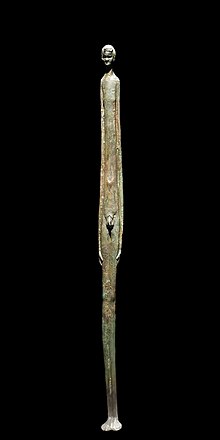Ombra della sera
The ombra della sera ( German shadow in the evening ) is an Etruscan votive statuette made of bronze and probably dates from the 3rd century BC. The figure is now kept in the Museo Etrusco Guarnacci in Volterra . It is one of the most famous sculptures in Etruscan art .
Origin of name
The term shadow in the evening probably refers to the long shadow that a person casts on the evening before sunset. This characterization of the statuette allegedly came from Gabriele D'Annunzio , an Italian writer of symbolism and poet of the fin de siècle , who is considered to be the source of ideas for Italian fascism . Ombra della sera is documented for the first time in a travel guide to Volterra from 1954, which was written by Paolo Ferrini . Ferrini was probably not the author , rather Ombra della sera seems to have been a name for the bronze statuette that was already widespread at the time.
description
The statuette is 57.5 cm high and is made of bronze, an alloy of copper and tin . It depicts an upright, naked male person with arms drawn to his sides and legs closed. The figure is noticeably elongated and appears vertically distorted, only the head corresponds to the natural proportions . The hairstyle , the round face shape and the implied smile give the figure a boyish appearance. The individual physical characteristics such as hands, feet and genitals are carefully worked out.
background
The bronze figure seems to have been a votive offering. In antiquity, votive gifts were votive gifts that were used to try to please deities or to express special gratitude to them for a favor or favor. Votive offerings were often offered publicly at a place of worship as a symbolic sacrifice based on a vow . These gifts were made from a wide variety of materials, including clay , terracotta , bronze, wrought iron , silver and brass . Votive offerings could also have very different forms. There are figurative representations of people as well as replicas of diseased body parts. In addition to sculptural votive offerings, relief-like votive tablets were also made. The finds from the Etruscan period are particularly numerous.
The statuette is not an isolated work of art , but belongs to a series of votive offerings that are well documented in Etruria . These bronze figures do not follow the canon of Greek body proportions, but are characterized by an exaggerated elongation of the body. The beginnings of this inanatomical formation of the body go back to the late Archaic period of the late 6th century BC. BC back. The workshops in Volterra in particular were known for their special skills in melting the copper minerals from the nearby Colline Metallifere with tin and processing them into bronze. In the second half of the 3rd century BC Numerous statuettes were produced in Volterra, which correspond to this bronze figure in terms of design and dimensions. The individual characteristics of the youthful figure, which influenced the Greek portraiture of the 3rd century BC, are unusual . Refer. The unstable, floating impression conveyed by the slender statuette particularly inspired the artist Alberto Giacometti in the design of his sculptures.
Provenance
There is no reliable information about the time and place of discovery of the bronze figure. The archaeologist and draftsman Francesco Inghirami (1772–1846) mentioned systematic excavations in Volterra between 1728 and 1737 in the fourth volume of his work I Monumenti Etruschi between 1728 and 1737. If one assumes a site in Volterra, a discovery of the figure seems very likely during this period. According to a well-known but unfounded anecdote , a French archaeologist is said to have observed how a farmer used the bronze figure to stoke the wood. What seems certain, however, is that the statuette was in the collection of the Buonarroti family in Florence in the 1730s . The priest and archaeologist Antonio Francesco Gori (1691–1757) discovered the statuette there and published a drawing in his work Museum Etruscum in 1737, stating that it came from Volterra. Gori described the bronze figure as a youthful deity and suspected a representation of the day of God , who was considered the son or grandson of Tinia and who is said to have taught the Etruscan Tarchon the art of divination . A few decades later, the noble abbot Mario Guarnacci (1701–1785) came into possession of the statuette and bequeathed it to the city of Volterra along with his collection. As a result, a museum was founded that was later named Museo Etrusco Guarnacci . The bronze figure is still kept there.
literature
- Sybille Haynes: Etruscan Civilization: A Cultural History. Getty Publications, Los Angeles 2000, ISBN 0892366001 , p. 373.
- Jean MacIntosh Turfa (Ed.): The Etruscan World. Routledge, New York 2013, ISBN 9781134055234 , p. 167.
- Friedhelm Prayon: The Etruscans. History, religion, art. 5th edition. CH Beck, Munich 2010, ISBN 9783406598128 , pp. 108-110.
Web links
- Ombra della sera. In: Museo Etrusco Guarnacci. Consorzio Turistico Volterra Valdicecina Valdera, accessed on July 24, 2020 .
- Paolo Ferrini: L'Ombra della sera. In: Etruschi (Rasenna) fra storia e mito: scritti di Cateni, Ferrini, Gatto. Il Sillabario, August 4, 2013, accessed July 24, 2020 .


